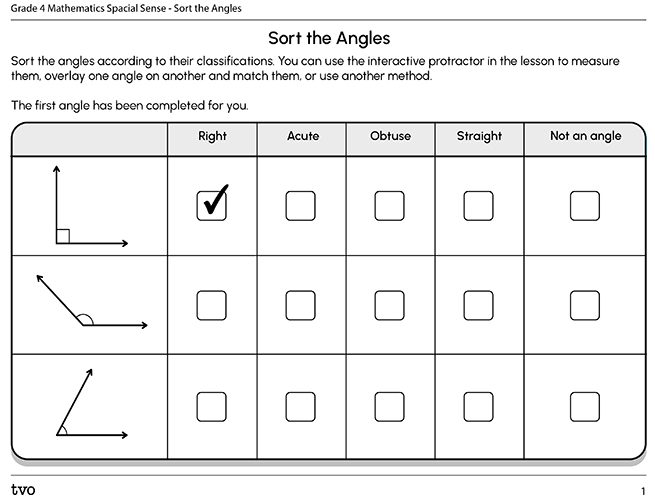Minds On
Discussing shapes
Explore the following two-dimensional shapes. Think about these questions as you explore the shapes:
- What are some similarities and differences?
- How could you sort these shapes?
- What do you notice about the vertices? How are they similar or different?
Record your ideas using a method of your choice.

There are 5 shapes: a square, which has 4 equal sides; a rectangle, which has 4 sides, 2 longer and two shorter; a triangle, which has 3 sides; a pentagon, which has 5 sides; and a hexagon, which has 6 sides.
Action
Identifying angles
An angle is a shape formed by two rays (‘arms’ of an angle), or two line segments, that meet at a common endpoint (vertex).

Angles are found when two lines intersect, or meet, at a common endpoint (vertex).
For example, they are found on three-dimensional objects and two-dimensional shapes, wherever two line segments meet.

Identifying the size of an angle involves finding the amount of rotation between two lines, segments, or rays that meet at a vertex. We measure the inside portion of the angle or the space between the two line segments.
Therefore, the size of the angle is not affected by the length of its arms or by the direction the angle is placed.

Explore the following examples, and decide if the angles are the same.
If the angles are the same, select true; if the angles are different, select false.
Classifying angles
There are four different classifications of angles: right, acute, obtuse, and straight.

Let’s explore each type of angle.
Press on the tabs to learn more about angles.
A right angle is an angle that measures 90 degrees.
- A right angle is a quarter turn.
- It is sometimes called a “square angle” because all angles of a square (or rectangle) are right.
- If two lines meet at a right angle, the lines are perpendicular (meaning they intersect at 90 degrees).

An acute angle measures between 0 degrees and 90 degrees.
- This angle is smaller than a 90-degree angle.

An obtuse angle is more than 90 degrees but less than 180 degrees.

A straight angle measures 180 degrees.
- This occurs when the rays lie opposite of each other.
- This creates a straight line.

Your turn!
Check your understanding by selecting the requested angle from each set or pair of angles.
Sort the angles
In this activity, you will sort ten angles by classifying them as: right, acute, obtuse, straight, or not an angle. You can record your thinking in the fillable and printable Sort the Angles Chart, or use a method of your choice.
Important: Two of the "angles" in this activity are not actually angles! Can you identify the fake angles?
As you explore the angles, remember these tips:
- A turn greater than a right angle is an obtuse angle.
- A turn less than a right angle is an acute angle.
- A half turn, where the arms of the angle create a straight line, is a straight angle.
Let’s begin! Explore the following angles, and decide on how to classify them.
If you’d like, you can use the interactive protractor to measure the angles.
Let’s explore a protractor! Try using it yourself, and ask for help if you need it!
To rotate the protractor input the number of degrees you would like to rotate the protractor by and use the buttons to select the direction of rotation.
Complete the fillable and printable Sort the Angles Chart to sort all the angles. You can also sort them in your notebook, or use another method of your choice.
Consolidation
Independent practice
Explore the following five-pointed star.
The star is made of five triangles and a pentagon in the centre.

Answer the following questions about the star.
Record your ideas in a notebook or a method of your choice.
- How many angles does the pentagon have? What type(s) of angles are these?
- There are 5 triangles. How many angles are there all together? How would you identify each angle? Are there any right angles? How do you know?
- What might be the other angles? Are there any other spots where two lines meet at a vertex?
Think about your learning
Record your ideas to the following questions in a notebook or a method of your choice.
- Why is it important to understand the different types of angles?
- Why does the length of the rays not matter when exploring the size of the angle?

Reflection
As you read through these descriptions, which sentence best describes how you are feeling about your understanding of this learning activity? Press the button that is beside this sentence.
I feel...
Now, record your ideas using a voice recorder, speech-to-text, or writing tool.
Connect with a TVO Mathify tutor
Think of TVO Mathify as your own personalized math coach, here to support your learning at home. Press ‘TVO Mathify’ to connect with an Ontario Certified Teacher math tutor of your choice. You will need a TVO Mathify login to access this resource.
TVO Mathify (Opens in a new tab)